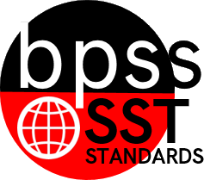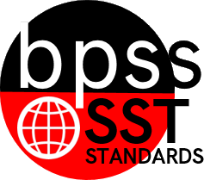SST-HS.3.01
|
High School SST Targeted Benchmarks
Standard 3: Economic Concepts
Students understand economic concepts and the characteristics of various economic systems.
Concepts
SST-HS.3.01 Analyze basic micro and macroeconomic concepts (e.g., scarcity, opportunity cost, trade-offs, markets, business organizations, factors of production, supply and demand, and personal finance).
|
Student Learning Targets:
Knowledge Targets
- I can identify the 3 basic economic questions.
- I can identify the 4 factors of production.
- I can identify what causes a change in quantity demanded.
- I can identify other types of business activities.
Reasoning Targets
- I can compare and contrast microeconomics to macroeconomics.
- I can analyze the different business organizations. (ie. Sole Proprietorship, Partnership, Corporation, Cooperatives)
- I can evaluate the impact of scarcity on the economic system.
- I can analyze a supply/demand curve and supply/demand schedule.
- I can explain the Laws of Supply and Demand.
- I can interpret what causes a change in supply and demand.
- I can distinguish between an elastic and inelastic product.
- I can distinguish between the Three Stages of Production.
- I can explain the Theory of Production.
- I can interpret what causes a change in supply.
- I can interpret what causes a change in quantity supplied.
- I can compare and contrast the four types of business organizations.
Skills (Performance) Targets
- I can apply opportunity cost to my economic decision making.
- I can demonstrate the impact of scarcity on our economic system.
- I can demonstrate the impact of supply and demand on economic decisions.
- I can explore money management skills.
- I can demonstrate the role of markets in our economy in the context of circular flow.
- I can demonstrate the concept of equilibrium price.
Proficiency Scale
| Score |
|
Description |
Sample Activity
|
| Advanced Proficient |
In addition to expectations of proficiency, the student provides consistent evidence of in-depth inferences and applications that go beyond what was taught and expected. |
- |
| |
3.5 |
In addition to score 3.0 performance, in-depth inferences, and applications with partial success. |
|
Proficient
|
“The Standard.” The student demonstrates no major errors or omissions regarding any of the information and processes that were end of instruction expectations.
Unit 1 Basic Economic Concepts
The student can:
-
describe the impact of scarcity on individuals and businesses.
-
explain how the three basic economic questions are answered in our economic system.
-
model the circular flow of goods, services, resources and money in the economy.
-
apply opportunity cost to economic decision making.
Unit 2 Demand
The student can:
-
explain the impact of demand on economic decisions.
-
analyze a demand curve and demand schedule and explain how they demonstrate the law of demand.
-
interpret the impact of a change in quantity demanded on the demand curve.
-
interpret what causes a change in demand and the impact of the demand curve.
-
determine the elasticity of a product. (elastic, inelastic, unit elastic)
-
analyze a demand curve and demand schedule to determine the market and individual demand for a product
Unit 3 Supply
The student can:
-
explain the impact of supply on economic decisions.
-
analyze a supply curve and supply schedule.
-
explain the law of supply.
-
interpret what causes a change in supply
-
interpret what causes a change in quantity supplied
-
explain the concepts of surplus, shortage and equilibrium price
-
explain the Theory of Production.
-
analyze examples to distinguish between fixed, variable and total costs, as well as revenue and profits.
-
explain how to determine the break-even point and how many workers are needed to make a profit.
Unit 4 Business Organizations
The student can:
-
compare and contrast sole proprietorships, partnerships, corporations, and cooperatives.
-
compare and contrast other types of business activities (conglomerates, multinationals, non-profits, labor union, and professional association)
Unit 7 Credit and Personal Finance
The student can:
- Create a personal budget.
The student exhibits no major errors or omissions.
|
- |
| |
2.5 |
The student demonstrates no major errors or omissions regarding the simpler details and processes (Score 2.0 content) and partial knowledge of the more complex ideas and processes (Score 3.0 content). |
| Progressing |
The student demonstrates no major errors or omissions regarding the simpler details and processes but exhibits major errors or omissions regarding the more complex ideas and processes (Score 3.0 content).
Unit 1 Basic Economic Concepts
The student can:
- recognizes or recalls specific terminology, such as:
- Economic system, scarcity, need, want, what to produce, how to produce, for whom to produce, land, labor, capital, entrepreneurs, goods, services, resources, financial capital, trade-off, opportunity cost, factor market, product market
- performs basic processes, such as:
- identifying the three basic questions
- identifying the four factors of production
- describing scarcity
- identifying the general process of circular flow
Unit 2 Demand
The student can:
-
recognizes or recalls specific terminology, such as:
-
Demand, demand curve, demand schedule, law of demand, change in quantity demanded, change in demand, elasticity, demand elasticity, elastic demand, inelastic demand, unit elastic demand, substitutes, complements, market demand, individual demand, microeconomics
-
performs basic processes, such as:
-
describing demand
-
creating a demand curve and demand schedule
-
identifying the cause of a change in quantity demanded
-
identifying the causes of a change in demand
-
listing the determinants of demand elasticity used to distinguishing between an elastic product and an inelastic product.
Unit 3 Supply
The student can:
-
recognizes or recalls specific terminology, such as:
-
Supply, supply curve, supply schedule, law of supply, change in quantity supply, change in supply, surplus, shortage, equilibrium price, theory of production, total product, marginal product, increasing returns, diminishing returns, negative returns, fixed costs, variable costs, total costs, revenue, profits, break-even point
-
performs basic processes, such as:
-
explaining supply
-
creating a supply curve and supply schedule
-
identifying the cause of a change in quantity supplied
-
identifying the causes of a change in supply
-
describing a surplus, shortage, and equilibrium price
-
describing the following: fixed, variable and total costs, revenue, profits, break-even point
Unit 4 Business Organizations
The student can:
-
recognizes or recalls specific terminology, such as:
-
sole proprietorships, partnerships, corporations, stock, cooperatives, merger, horizontal merger, vertical merger, conglomerates, multinationals, non-profits, labor union, professional association, general partnership, limited partnership, direct roles of government, indirect roles of government, common stock, preferred stock, limited life, unlimited life, limited liability, unlimited liability
-
performs basic processes, such as:
-
identifying key elements of sole proprietorships, partnerships, corporations, and cooperatives.
-
identifying other types of business activities (conglomerates, multinationals, non-profits, labor union, and professional association).
Unit 7 Credit and Personal Finance
The student can:
- Identify monthly expenses
However, the student exhibits major errors or omissions regarding the more complex ideas and processes.
|
- |
| |
1.5 |
The student demonstrates partial knowledge of the simpler details and processes (Score 2.0 content) but exhibits major errors or omissions regarding the more complex ideas and procedures (Score 3.0 content). |
| Novice |
With help, the student demonstrates a partial understanding of some of the simpler details and processes (Score 2.0 content) and some of the more complex ideas and processes (Score 3.0 content). |
- |
| |
0.5 |
With help, the student demonstrates a partial understanding of some of the simpler details and processes (Score 2.0 content) but not the more complex ideas and processes (Score 3.0 content). |
Resources
Websites
Vocabulary |
 BPS District Social Studies Standards Book
BPS District Social Studies Standards Book

 Standard 1:
Standard 1: